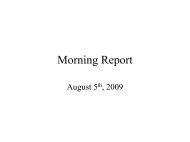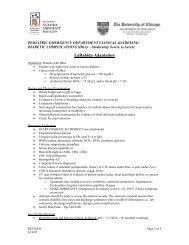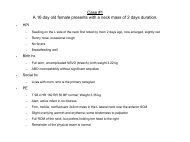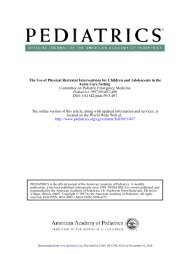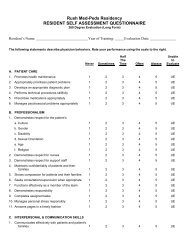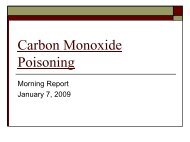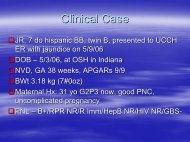28 Wilson's Disease
28 Wilson's Disease
28 Wilson's Disease
You also want an ePaper? Increase the reach of your titles
YUMPU automatically turns print PDFs into web optimized ePapers that Google loves.
Morning Report<br />
Chief Residents<br />
July <strong>28</strong>, 2011
16 year old F with emesis
• 1 wk of RUQ pain, NV, fatigue<br />
• NB, daily. +Green on day of<br />
presentation<br />
• RUQ pain<br />
– worsened by movement<br />
– relieved by rest<br />
– crampy in nature<br />
– begins epigastric, radiates to L side<br />
• Seen in ER 4 d PTA for emesis<br />
– dx w/ viral gastro<br />
– slight elevation seen in LFTs<br />
• Similar episode ~6 mo ago w/ nl<br />
lab work<br />
History<br />
• PMH: None<br />
• Menstrual Hx: NL, regular<br />
cycles with manageable<br />
cramps<br />
• PSH: None<br />
• Meds: None<br />
• Imm: UTD<br />
• Social Hx:<br />
– LAHW M, D, Sib<br />
– Working on a cattle farm for the<br />
summer.<br />
– Will be a senior in HS<br />
– No drugs, sex, smoking, EtOH.<br />
– Active varsity soccer player<br />
• FH: No Hx of GI or AI disease<br />
• Allergies: None
• GI<br />
– Hepatitis<br />
Differential Diagnosis<br />
– Drug induced hepatitis<br />
– Autoimmune hepatitis<br />
– Peptic ulcer disease<br />
– SBO<br />
– Appendicitis<br />
– Viral gastroenteritis<br />
– Cholecystitis<br />
– Pancreatitis<br />
• Repiratory<br />
– PNA<br />
• Onc:<br />
– Abdominal, intracranial or hepatic<br />
mass<br />
• Endo<br />
– DKA<br />
• Neuro<br />
• ID<br />
– Increased ICP<br />
– Post-concussive syn<br />
– Intracranial bleed<br />
– Migraine HA<br />
– STI<br />
– EBV<br />
• Other<br />
– Drug exposure, overdose, withdrawl<br />
– Pregnancy<br />
– Cyclic vomiting syndrome
Physical Exam<br />
Vitals: T36.6 HR67 RR14 BP 116/58<br />
O2sat: 100% BMI 22<br />
General: Well appearing F, tired but arousable<br />
Heent: Scleral Icterus, Jaundice noted under tongue, MM, PERRLA,<br />
EOMI, TMs WNL<br />
CV: RR, no murmur, NL S1 and S2<br />
Resp: CTAB, no crackles, wheezes, rales<br />
Abd: Soft. Bowel sounds are normal. No distension, no ascites and no<br />
mass. + Hepatosplenomegaly (Liver edge is palpable at about 5<br />
FBBCM, span is about14 cm) or splenomegaly. No tenderness. No<br />
hernia.<br />
Neuro: AOx3, GCS 15, unable to conduct serial 7s, strength,<br />
senasation, tone WNL, CN II-XI WNL<br />
Skin: + Diffuse jaundice visualized, particularly on stomach. No palmar<br />
erythema, no spider veins noted
138 / 3.6 | 110 / 22 | 16 / 1.2 < 99<br />
Ca 8.1<br />
4.8 | 2.9<br />
11.9 | 6.7c<br />
92 /\ 53<br />
20<br />
9.8 > 5.8 / 18.4
Wilson’s <strong>Disease</strong><br />
• AR defect in Copper transport resulting in<br />
liver deposition and damage<br />
• 1 in 30,000 live births
Dietary Copper<br />
http://www.google.com/imgres?imgurl=http://images.sciencedaily.com/2007/03/070305092013.jpg&imgrefurl=http://www.scienced<br />
aily.com/releases/2007/03/070305092013.htm&usg=__oEsFaqIOqU5SrqgSbsWsYFMHLRQ=&h=197&w=300&sz=19&hl=en&sta<br />
rt=1&sig2=0_eHLVNkck9TjzTkqBbyFQ&zoom=1&tbnid=ga6NC1onbpA5EM:&tbnh=76&tbnw=116&ei=8qZXToLSIYyTtweGiNWw<br />
DA&prev=/images%3Fq%3Ddietary%2Bcopper%26um%3D1%26hl%3Den%26tbm%3Disch&um=1&itbs=1
2 diseases involving Cu transport<br />
Wilson’s <strong>Disease</strong><br />
• Decreased transport<br />
of Cu from liver to<br />
bile<br />
• Cu excess<br />
• …More to come....<br />
Menkes’ <strong>Disease</strong><br />
• X linked<br />
• Severe<br />
neurodegeneration<br />
• Defect in Cu transport<br />
• Cu deficiency<br />
• Seizures, FTT, DD,<br />
Kinky silver hair
Pathophysiology<br />
• Mutation in gene ATP7A on Chromosome 13<br />
• Decreased incorporation of copper into<br />
apoceruloplasm<br />
– Decreased formation and secretion of ceruloplasm<br />
• Decreased copper excretion in bile<br />
– Loss of primary excretory mechanism<br />
• Both increased liver concentrations of Cu<br />
– Cu forms free radicals and injures hepatocytes
Fatty infiltration and portal<br />
fibrosis<br />
Pathology<br />
Cirrhosis
• Teenage years<br />
Signs and Symptoms<br />
• Silent disease until intra-hepatic and extra-hepatic copper<br />
deposition begins to manifest clinically<br />
– Age 6-30<br />
• Incidental elevated LFT Overt liver failure<br />
• <strong>28</strong>2 patients:<br />
– Neurologic 69%<br />
• Parkinsonism, Dystonia, Cerebellar and Pyramidal sings<br />
– Hepatic 15%<br />
– Hepato-neurologic 2.5%<br />
– Osseomuscular 2%<br />
– Pure psychiatric 2%<br />
– Asymptomatic 5%
Our patient’s slit lamp exam
Fulminant Hepatic Failure<br />
• Usually teens or young adults<br />
• Symptoms<br />
– Variceal bleeding<br />
– Portal hypertension<br />
– Decreased synthetic function<br />
– Associated with hemolytic anemia<br />
• Due to release of copper into circulation<br />
• Hemoglobinuria, dark urine, renal failure<br />
• Ominous prognosis<br />
• Indication for urgent liver transplant
Diagnosis<br />
• Coomb’s negative hemolytic anemia<br />
• Elevated bilirubin & LFTs with low AlkPhos<br />
• Low serum ceruloplasm and high urinary<br />
copper excretion<br />
• Gold Standard: High Tissue Content of<br />
Copper on Liver Biopsy (> 250ug/g dry<br />
weight)
Uptodate.com
• 2 phases<br />
– Removal of copper<br />
Treatment<br />
– Preventing re-accumulation<br />
• Evaluation of siblings
• D-penicillamine<br />
– Cu chelating moiety<br />
Chelators<br />
– Reduces the affinity of proteins for copper, allowing<br />
previously protein bound copper to bind penicillamine<br />
– Excretion via urination<br />
– 30% of pts do not tolerate long term 2/2 SE<br />
– Early SE- drug sensitivity reactions<br />
– Late SE: nephrotic syndrome, bone marrow toxicity,<br />
hepatotoxicity, Goodpasture
• Trientine<br />
– Cu chelator<br />
Chelators<br />
• Forms a stable complex with four nitrogens and Cu<br />
• Increases renal excretion<br />
– Lower incidence of SE<br />
– Higher price
Zinc<br />
• Interefers with absoption of Cu<br />
• Induces metallothionein in enterocytes<br />
which has a high Cu affinity binding of<br />
lumical copper and prevention of entry into<br />
circulation fecal excretion during<br />
exterocyte turnover
Dietary Recommendations<br />
• Limit intake of foods high in copper<br />
– Water testing if gathered from well<br />
– Evaluation if homes have copper water pipes
Fulminant Hepatic Failure<br />
• Emergent Liver Transplant<br />
• Supportive Care
Liver Transplant Complications<br />
• Infection<br />
– Peri-operative<br />
–Post-op<br />
– Immunosuppresion<br />
• Acute Rejection<br />
• Hepatic Artery<br />
Thrombosis<br />
• Biliary leak<br />
• Chronic Rejection<br />
• PTLD<br />
• <strong>Disease</strong> Recurrence<br />
• Morbidity associated<br />
with immunosuppresive<br />
drugs
https://louisville.edu/medschool/gimedicine/division-lecture-files/marsano-lectures/Post-Liver-Transplant%20Complications.pdf
Back to our patient….<br />
Listed as 1A for Liver Transplant<br />
Transferred to ICU<br />
Started on Penicillamine<br />
Developed ARF<br />
Transitioned to Trientine<br />
Improved LFTs and mental status<br />
Discharged home after 11d admission
Objectives<br />
• Review the differential diagnosis of emesis<br />
• Review the biologic role of copper<br />
• Compare Wilson’s disease to Menke’s<br />
disease<br />
• Review the symptoms, diagnosis and<br />
treatment of Wilson’s disease<br />
• Briefly review complications associated<br />
with liver transplant




